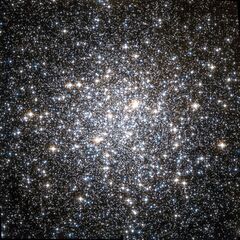Astronomy:NGC 6723
From HandWiki
Short description: Globular cluster in the constellation Sagittarius
| NGC 6723 | |
|---|---|
 NGC 6723 by Hubble Space Telescope; 3.5′ view | |
| Observation data (J2000 epoch) | |
| Class | VII[1] |
| Constellation | Sagittarius |
| Right ascension | 18h 59m 33.15s[2] |
| Declination | –36° 37′ 56.1″[2] |
| Distance | 28.4 kly (8.7 kpc)[3] |
| Apparent magnitude (V) | 6.8[4] |
| Apparent dimensions (V) | 11′[4] |
| Physical characteristics | |
| Mass | 3.57×105[3] M☉ |
| Metallicity | [math]\displaystyle{ \begin{smallmatrix}\left[\ce{Fe}/\ce{H}\right]\end{smallmatrix} }[/math] = –0.96[5] dex |
| Estimated age | 13.06 Gyr[5] |
NGC 6723 is a globular cluster[6] in the constellation Sagittarius. Its magnitude is given as between 6 and 6.8, and its diameter is between 7 and 11 arcminutes. It is a class VII cluster with stars of magnitude 14 and dimmer. It is near the border of Sagittarius and Corona Australis.
Unlike common globular clusters, NGC 6723 has an enhanced metallicity and a large fraction of younger stars, with primordial stars accounting for only 0.363±0.017 % of the total.[7]
References
- ↑ Shapley, Harlow; Sawyer, Helen B. (August 1927), "A Classification of Globular Clusters", Harvard College Observatory Bulletin 849 (849): 11–14, Bibcode: 1927BHarO.849...11S.
- ↑ 2.0 2.1 Goldsbury, Ryan et al. (December 2010), "The ACS Survey of Galactic Globular Clusters. X. New Determinations of Centers for 65 Clusters", The Astronomical Journal 140 (6): 1830–1837, doi:10.1088/0004-6256/140/6/1830, Bibcode: 2010AJ....140.1830G.
- ↑ 3.0 3.1 Boyles, J. et al. (November 2011), "Young Radio Pulsars in Galactic Globular Clusters", The Astrophysical Journal 742 (1): 51, doi:10.1088/0004-637X/742/1/51, Bibcode: 2011ApJ...742...51B.
- ↑ 4.0 4.1 "Data for NGC 6723". http://www.ngcicproject.org.
- ↑ 5.0 5.1 Forbes, Duncan A.; Bridges, Terry (May 2010), "Accreted versus in situ Milky Way globular clusters", Monthly Notices of the Royal Astronomical Society 404 (3): 1203–1214, doi:10.1111/j.1365-2966.2010.16373.x, Bibcode: 2010MNRAS.404.1203F.
- ↑ "SIMBAD Astronomical Object Database". Results for NGC 6723. http://simbad.u-strasbg.fr/Simbad.
- ↑ Lee, Jae-Woo (2019), "Multiple Stellar Populations of Globular Clusters from Homogeneous Ca–CN–CH Photometry. V. cn′JWL as a Surrogate cnJWL Index and NGC 6723", The Astrophysical Journal 883 (2): 166, doi:10.3847/1538-4357/ab3d34
- Robert Burnham Jr, Burnham's Celestial Handbook: An observer's guide to the universe beyond the solar system, vol 3, p. 1558
External links
- NGC 6723 on WikiSky: DSS2, SDSS, GALEX, IRAS, Hydrogen α, X-Ray, Astrophoto, Sky Map, Articles and images
- NGC 6723
Coordinates: ![]() 18h 59m 33.1s, −36° 37′ 53.3″
18h 59m 33.1s, −36° 37′ 53.3″
 |


